COOPERATION MODEL
ARTIFICIAL INTELLIGENCE
PRODUCT ENGINEERING
DevOps & Cloud
LOW-CODE/NO-CODE DEVELOPMENT
INDUSTRY
FRONTEND DEVELOPMENT
CLOUD DEVELOPMENT
MOBILE APP DEVELOPMENT
LOW CODE/ NO CODE DEVELOPMENT
EMERGING TECHNOLOGIES







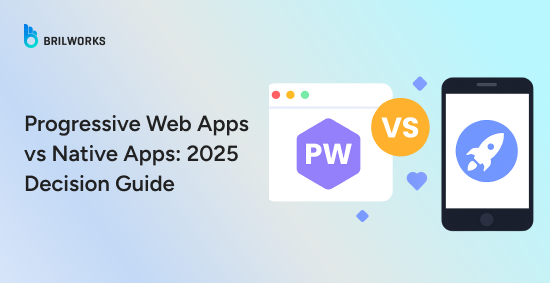
There are countless examples of successful progressive web apps such as Uber, Twitter Lite, Pinterest, and Spotify. The concept of progressive web apps was introduced by Google in 2015. The term was popularized by Alex Russell, a Google engineer, and Frances Berriman, a designer, who outlined the idea of web apps that could behave like native apps while remaining accessible through the web.
So when you weigh progressive web apps vs native apps, PWAs can do almost everything a native app can without the hassle of app stores. That got businesses asking themselves: if a web app can do so much, why build a native one at all? The reason is the line between progressive web apps vs native isn’t always clear, and that’s exactly what this article will unpack.
Technically, progressive web apps are built with web technologies and are designed to feel like native apps. They offer features such as push notifications, offline access, and background updates. You can install them on smartphones, and they can use hardware features like the camera, GPS, and accelerometer. While they are built like web apps, they provide an experience similar to native or cross-platform apps.
To simplify, a Progressive Web App is essentially a website that functions like a mobile app. You don’t need to go to the app store to install it. Plus it can sit on your phone or desktop just like a normal app.
Here’s what it can do:
Work offline or when your internet is slow.
Load quickly so you don’t have to wait.
Send notifications to keep you updated.
Fit any screen—phone, tablet, or computer.
Be added to your home screen like a real app.
Behind the scenes, it’s still built with standard front end technologies or web development languages, such as HTML, CSS, and JavaScript, along with a few additional tools (or frameworks) to give it the appearance of an app.
In short, progressive web apps let companies offer an app-like experience without having to create separate versions for iPhone, Android, and the web.
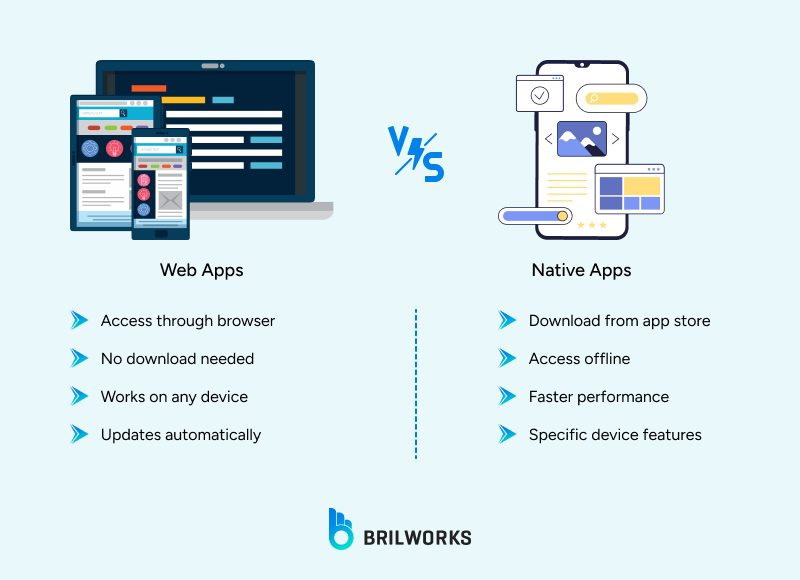
Native apps are built specifically for each platform using that platform's programming language. They are considered premium apps and generally offer better performance than hybrid, cross-platform, or progressive web apps.
For example, apps like Photos and Mail are native apps. Building a native app requires developers with different skills, such as Java or Kotlin for Android and Swift for iOS.
Native apps are built for a specific platform, like iOS or Android, and offer top performance. PWAs provide a good user experience but may not take full advantage of all device features.
Native apps need to be developed separately for each platform, which increases costs and takes more time. PWAs use a single codebase for all platforms, making development faster and less expensive.
Native apps are distributed through app stores, while PWAs can be accessed directly through browsers, so users don't need to install them.
Native apps are not indexed by search engines, but PWAs are web-based and can be found through search engines.
PWAs are a good choice for businesses that want to reach a wide audience without high development costs. Native apps are better for projects that need top performance.
See Also: Nodejs vs Top backend Technologies
|
Criteria |
PWA |
Native App |
|
Development Cost |
Lower |
Higher |
|
Time to Market |
Faster |
Slower |
|
Performance |
Good |
Excellent |
|
Device Integration |
Limited |
Full |
|
User Acquisition |
Browser-based |
App store-based |
|
SEO & Discoverability |
High |
Low |
|
Monetization Flexibility |
High |
Moderate to Low |
PWAs offer a significant cost advantage, with development costs typically 33-75% lower than native apps. This is primarily due to the single codebase approach. Additionally, PWAs can be developed in a shorter timeframe, often within 6-8 weeks, compared to the 12-16 weeks required for native apps.
Native Apps, while more expensive and time-consuming to develop, provide a higher return on investment in scenarios where performance and user experience are paramount. They are particularly beneficial for applications requiring deep device integration and advanced functionalities.
For startups and businesses that need to launch quickly and keep costs low, PWAs are a strong option. But if your company needs high performance and deep device integration, investing in native app development could pay off more in the long run.
Native Apps excel in performance, offering smooth and responsive user experiences. They are optimized for specific platforms, allowing for efficient use of device resources. This makes them ideal for applications involving complex computations, high-quality graphics, or intensive data processing.
PWAs, while improving in performance, still face limitations due to their reliance on browser capabilities. They may not fully leverage device hardware, potentially affecting performance in resource-intensive applications.
If your app needs top performance, like in gaming or augmented reality, native apps are the best choice. PWAs work well for content-focused apps where performance needs are not as high.
PWAs offer enhanced discoverability through search engines, as they are essentially websites that can be indexed. This allows for organic traffic generation and broadens the potential user base.
Native Apps rely on app store visibility for discoverability. While app stores provide a platform for user acquisition, they also introduce barriers such as approval processes and the need for users to download the app.
If your goal is to reach a large audience quickly and affordably, PWAs are a great choice. For apps that need to target specific users or require deep integration with a platform, native apps may be better.
Native Apps provide full access to device features, including camera, GPS, and biometrics. This allows for the development of feature-rich applications that can leverage the full capabilities of the device.
PWAs have limited access to device features, especially on iOS platforms. While they can access basic features like camera and geolocation, more advanced functionalities may be restricted.
For apps that need to work closely with device hardware, like fintech or healthcare apps, native apps are essential. PWAs are better for apps that don't need as much hardware access.
Native Apps benefit from operating system-level security features and app store review processes, providing robust protection against malware and unauthorized access.
PWAs rely on browser-level security, which, while strong, may not offer the same level of protection as native apps.
Recent studies have highlighted security gaps in PWA installation processes, underscoring the need for improved security measures.
If your app handles sensitive data, like in banking or healthcare, native apps provide stronger security. PWAs can also be secure, but they may need extra steps to address possible risks.
PWAs allow for instant updates without the need for app store approval, enabling developers to quickly address issues and release new features.
Native Apps require app store submission and user installation for updates, which can delay the rollout of new features and fixes.
If your business needs to update and improve your app often, PWAs make this process fast and easy. For apps that require careful version control and managed rollouts, native apps are a better fit.
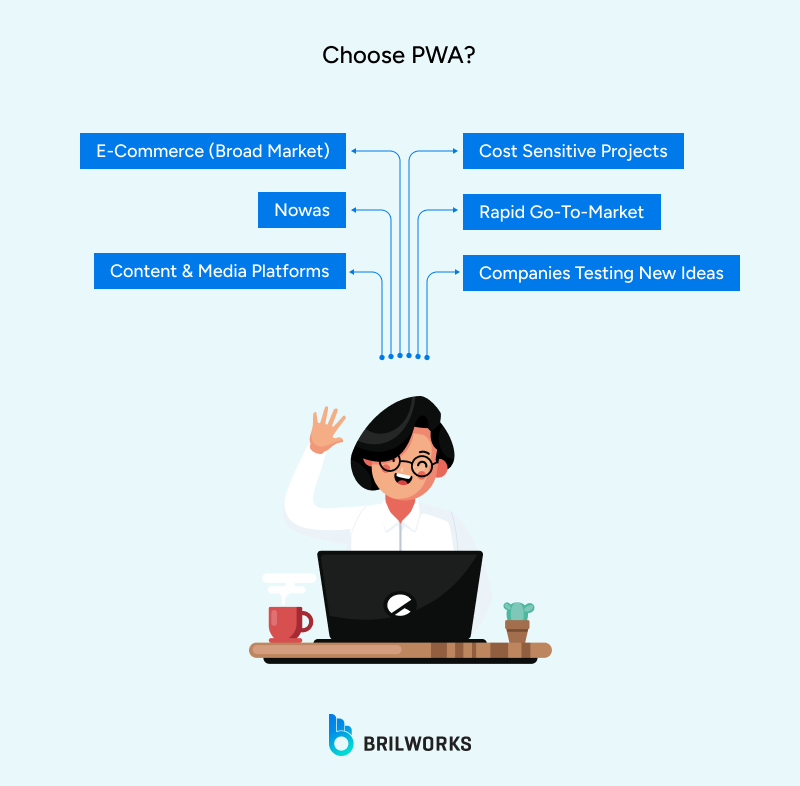
PWAs enable quick deployment, making them ideal for testing ideas and launching Minimum Viable Products (MVPs). Their single codebase approach reduces development time and costs, allowing businesses to validate concepts swiftly.
For content-heavy platforms, PWAs offer enhanced performance and user engagement. They provide a seamless experience across devices, ensuring users can access content effortlessly.
E-commerce platforms aiming for a wide reach benefit from PWAs by offering fast loading times and offline capabilities, improving user experience and conversion rates.
Startups and businesses with limited budgets can leverage PWAs to deliver app-like experiences without the high costs associated with native app development.
PWAs allow businesses to experiment with new features and functionalities, gathering user feedback before committing to full-scale development.
Starbucks implemented a PWA to enhance its ordering system, allowing users to browse menus and place orders offline. This approach led to increased user engagement and satisfaction, especially in areas with unstable internet connections.
Twitter introduced "Twitter Lite," a PWA designed for users in regions with limited internet connectivity. The PWA offered faster loading times and reduced data usage, resulting in a significant increase in user engagement and retention.
Pinterest revamped its mobile web experience by adopting a PWA, leading to improved performance and user engagement. The PWA's offline capabilities and fast loading times contributed to a better user experience, particularly in emerging markets.
Flipkart, one of India's leading e-commerce platforms, developed a PWA to cater to users with low-bandwidth connections. The PWA's fast loading times and offline capabilities resulted in increased user engagement and higher conversion rates.
AliExpress adopted a PWA to enhance its mobile shopping experience, leading to improved performance and user engagement. The PWA's lightweight design and offline capabilities contributed to a better user experience, especially in regions with limited internet connectivity.
If your app has heavy graphics, videos, or AR features, native apps handle it better. They are built for the phone, so everything works quickly and feels smooth.
Example: Instagram uses native code to handle real-time filters, video uploads, and AR effects without lag.
Apps that handle banking or health data need strong security. Native apps can use the phone’s built-in protections like fingerprint login, secure storage, and encryption.
Example: Banking apps like Chase or HSBC are native so your money and personal info stay safe.
If your app needs GPS, camera, sensors, or background location tracking, native apps do this reliably.
Example: Uber uses native code to track rides in real time and make sure drivers and riders get accurate updates.
Being on the App Store or Google Play gives credibility. People feel safer downloading apps from these stores and trust that they work.
Example: Spotify and Netflix use app stores not just to distribute their apps but to show users they are reliable.
Native apps can send notifications, work offline, and run background tasks. This keeps users coming back.
Example: Instagram and TikTok keep users engaged with notifications, smooth scrolling, and offline access.
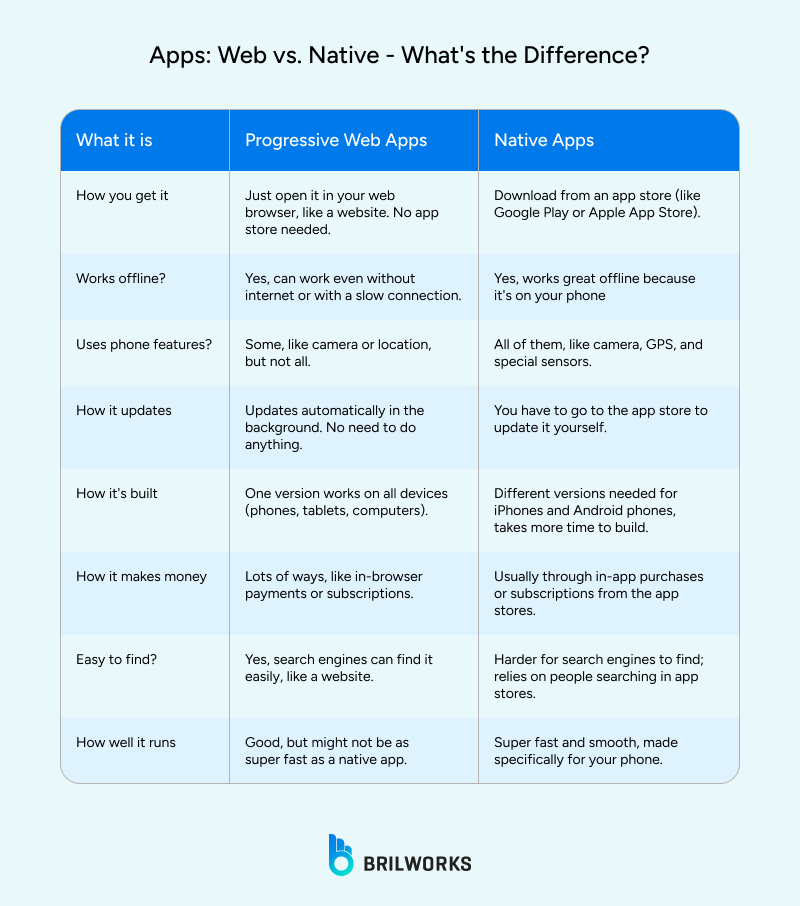
What is the main goal of the project? Test an idea quickly, reach lots of users, or build a feature-rich, high-performance app?
What is the budget? Low, medium, or high?
Do you need something fast, or can you invest time in multiple platform development?
Audience: Are they global, in regions with poor connectivity, or high-end device users?
Required features: Do you need deep hardware access, AR, push notifications, offline mode, or security for sensitive data?
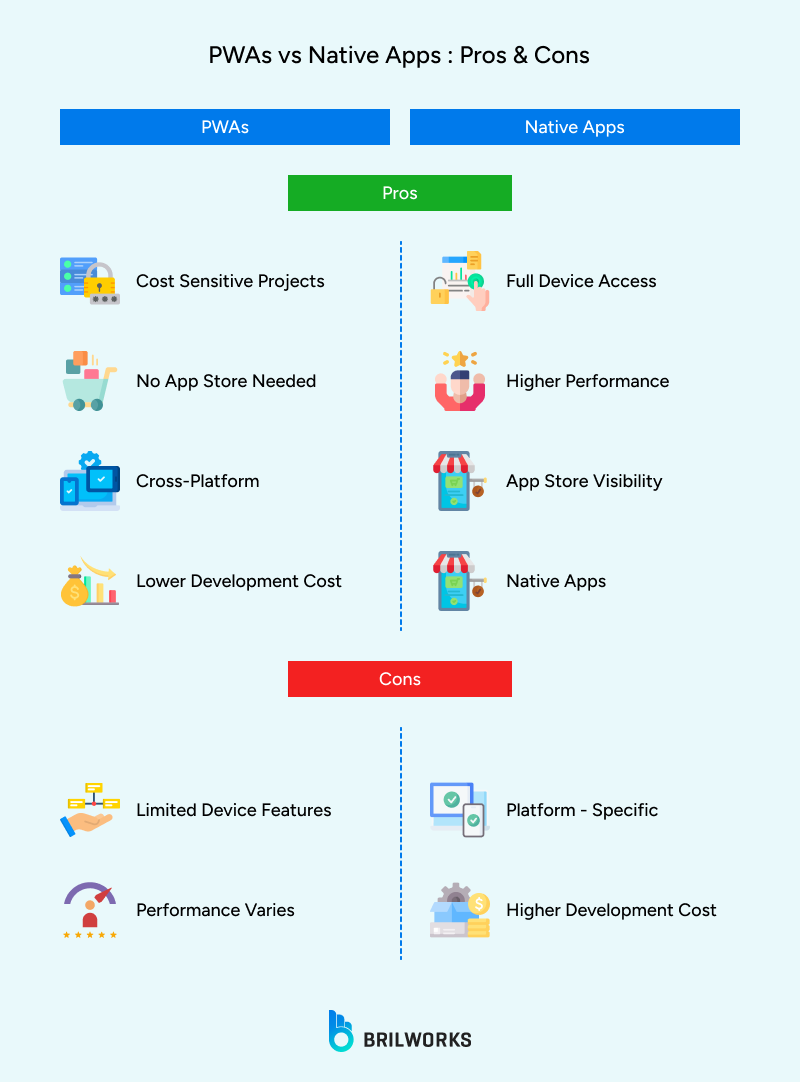
|
Test idea / MVP |
PWA |
Fast to launch, single codebase |
|
Broad audience / SEO reach |
PWA |
URL shareable, web discoverable |
|
Budget-conscious |
PWA |
Lower development and maintenance cost |
|
High-performance / AR |
Native |
Smooth, optimized for hardware |
|
Sensitive data / security |
Native |
OS-level encryption, secure storage |
|
Deep device integration |
Native |
Full access to camera, GPS, sensors |
|
Brand trust / app store |
Native |
App store credibility and discoverability |
|
High user engagement |
Native |
Notifications, offline, background tasks |
In short, PWAs are ideal for quick launches, broad reach, and lower development costs, while native apps excel when you need top performance, advanced features, or strong security.
Choosing the right approach can be tricky, and the right strategy depends on your project goals and audience. To make it easier, we offer tailored solutions that help businesses build apps that fit their needs. Learn more about our app development services.
Progressive web apps (PWAs) differ from traditional web apps in several key ways. While traditional web apps are accessed solely through a browser and require an internet connection to function, PWAs are designed to provide an app-like experience. They can work offline or in low-connectivity environments, load faster, and offer features such as installation on a device’s home screen and push notifications, bridging the gap between the web and native applications.
The difference between a PWA and a traditional app lies primarily in how they are built and distributed. PWAs are web-based, built with standard web technologies like HTML, CSS, and JavaScript, and run across all platforms with a single codebase. Traditional native apps, on the other hand, are platform-specific, developed for iOS or Android using languages such as Swift or Kotlin, and provide full access to device hardware, better performance, and store-based distribution.
A PWA is not technically a mobile app, but it behaves like one. Users can install it on their mobile devices, access it from the home screen, and interact with it like a native app, yet it still runs through a browser and is web-based. This makes it a hybrid solution that combines the reach of the web with many functionalities of mobile apps.
Yes, PWAs can be built using React. Developers can use React to create the user interface and handle dynamic content, while service workers and manifest files enable offline functionality, installation prompts, and other app-like features. Frameworks like create-react-app even include built-in support for PWA functionality, making it straightforward to turn a React web app into a PWA.
PWAs are capable of sending push notifications using service workers and the Push API. This allows apps to engage users with updates even when the app is not open. While support is robust on most modern browsers such as Chrome, Edge, and Firefox, it is more limited on iOS Safari. Users must grant permission for notifications, but once enabled, PWAs can deliver alerts, reminders, and other interactive messages similar to native apps.
Get In Touch
Contact us for your software development requirements
Get In Touch
Contact us for your software development requirements